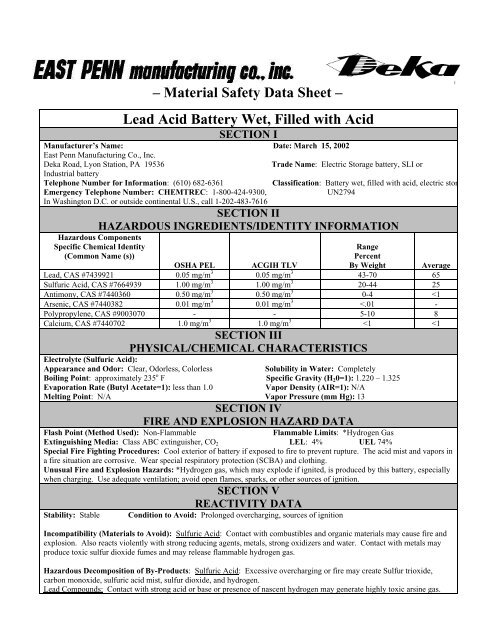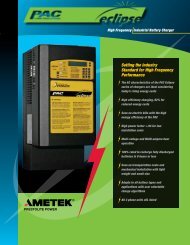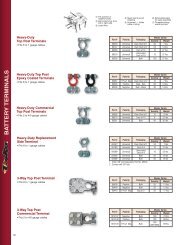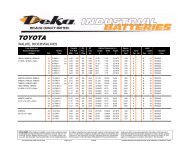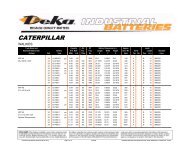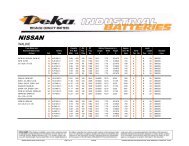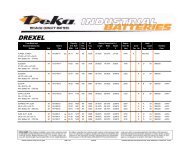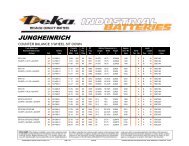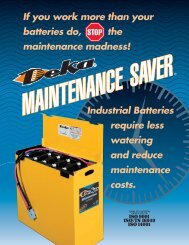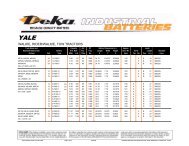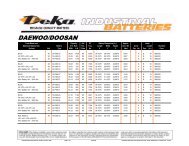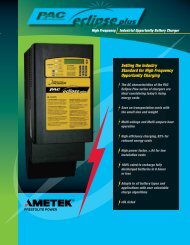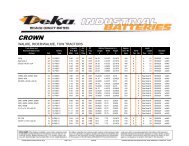â Material Safety Data Sheet â Lead Acid Battery Wet, Filled with Acid
â Material Safety Data Sheet â Lead Acid Battery Wet, Filled with Acid
â Material Safety Data Sheet â Lead Acid Battery Wet, Filled with Acid
Create successful ePaper yourself
Turn your PDF publications into a flip-book with our unique Google optimized e-Paper software.
– <strong>Material</strong> <strong>Safety</strong> <strong>Data</strong> <strong>Sheet</strong> –<br />
®<br />
<strong>Lead</strong> <strong>Acid</strong> <strong>Battery</strong> <strong>Wet</strong>, <strong>Filled</strong> <strong>with</strong> <strong>Acid</strong><br />
SECTION I<br />
Manufacturer’s Name: Date: March 15, 2002<br />
East Penn Manufacturing Co., Inc.<br />
Deka Road, Lyon Station, PA 19536<br />
Trade Name: Electric Storage battery, SLI or<br />
Industrial battery<br />
Telephone Number for Information: (610) 682-6361<br />
Classification: <strong>Battery</strong> wet, filled <strong>with</strong> acid, electric stor<br />
Emergency Telephone Number: CHEMTREC: 1-800-424-9300,<br />
UN2794<br />
In Washington D.C. or outside continental U.S., call 1-202-483-7616<br />
SECTION II<br />
HAZARDOUS INGREDIENTS/IDENTITY INFORMATION<br />
Hazardous Components<br />
Specific Chemical Identity<br />
(Common Name (s))<br />
OSHA PEL<br />
ACGIH TLV<br />
Range<br />
Percent<br />
By Weight<br />
Average<br />
<strong>Lead</strong>, CAS #7439921 0.05 mg/m 3 0.05 mg/m 3 43-70 65<br />
Sulfuric <strong>Acid</strong>, CAS #7664939 1.00 mg/m 3 1.00 mg/m 3 20-44 25<br />
Antimony, CAS #7440360 0.50 mg/m 3 0.50 mg/m 3 0-4
MSDS: <strong>Battery</strong> <strong>Wet</strong>, <strong>Filled</strong> <strong>with</strong> <strong>Acid</strong>; Page 2 of 3<br />
SECTION VI<br />
HEALTH HAZARD DATA<br />
Route(s) of Entry: Not Applicable under normal use. (Inhalation, skin contact, and ingestion)<br />
Health Hazards (Acute and Chronic): Do not open battery, avoid contact <strong>with</strong> internal components. Internal components<br />
are Oxide lead and electrolyte. Short term exposure: Sulfuric acid may cause irritation of eyes, nose, and throat. Prolonged<br />
contact may cause severe burns. Long term exposure: Repeated contact causes irritation and skin burns. Repeated exposure to<br />
mist may cause erosion of teeth, chronic eye irritation and/or chronic inflammation of the nose, throat, and bronchial tubes.<br />
TARGET ORGAN: (Electrolyte) respiratory system, eyes, skin, and teeth<br />
Carcinogenicity:<br />
Sulfuric <strong>Acid</strong>: The International Agency for Research on Cancer (IARC) has classified “strong inorganic acid mist containing<br />
sulfuric acid” as a Category 1 carcinogen, a substance that is carcinogenic to humans. This classification does not apply to<br />
liquid forms of sulfuric acid contained <strong>with</strong>in a battery. Inorganic acid mist (sulfuric acid mist) is not generated under normal<br />
use of this product. Misuse of the product such as overcharging, may result in the generation of sulfuric acid mist.<br />
<strong>Lead</strong> Compounds: <strong>Lead</strong> is listed as a 2B carcinogen, likely in animals at extreme doses. Proof of carcinogenicity in humans is<br />
lacking at present.<br />
Arsenic: Listed by National Toxicology Program (NTP), IARC, OSHA and NIOSH as a carcinogen only after prolonged<br />
exposure at high levels.<br />
Signs and Symptoms of Exposure: <strong>Acid</strong> contact may cause irritation of eyes, nose and throat. Breathing of mist may<br />
produce respiratory difficulty. Contact <strong>with</strong> eyes and skin causes irritation and skin burns. Sulfuric acid is a CORROSIVE<br />
chemical.<br />
Medical Conditions Generally Aggravated by Exposure: Sulfuric <strong>Acid</strong> Mist exposure may aggravate medical conditions<br />
such as, pulmonary edema, bronchitis, emphysema, dental erosion, and tracheobronchitis. Pregnant women and children must<br />
be protected from lead exposure.<br />
Emergency and First Aid Procedures: (Sulfuric <strong>Acid</strong>)<br />
1) Flush contacted area <strong>with</strong> large amounts of water for at least 15 minutes. Remove contaminated clothing and<br />
obtain medical attention if necessary. Eye wash and/or emergency shower should be readily available.<br />
2) If swallowed, give large volumes of water. DO NOT induce vomiting, obtain medical treatment.<br />
SECTION VII<br />
PRECAUTIONS FOR SAFE HANDLING AND USE<br />
Steps to be Taken in Case <strong>Material</strong> is Released or Spilled: SULFURIC ACID: Dilute spill cautiously <strong>with</strong> five to six<br />
volumes of water and gradually neutralize <strong>with</strong> sodium bicarbonate, soda ash or lime. When exposure level is not known, wear<br />
NIOSH approved positive pressure self-contained breathing apparatus. Reference North American Emergency Response<br />
Guidebook, #154.<br />
Waste Disposal Method: <strong>Lead</strong>-acid batteries are completely recyclable. For information on returning batteries to East Penn<br />
for recycling, contact your East Penn Representative. Dispose of any collected material in accordance <strong>with</strong> local, state or<br />
applicable federal regulations.<br />
Precautions to be Taken in Handling and Storing: Store away from reactive material as defined in Section V, Reactivity<br />
<strong>Data</strong>. Place cardboard between layers of stacked batteries to avoid damage and short circuit. Do not allow metallic materials<br />
to simultaneously contact both terminals.<br />
Other Precautions: Sodium bicarbonate, soda ash, sand, or lime should be kept in same general area for emergency use.<br />
Keep away from sources of ignition during charging see Section IV on generation of hydrogen gas. If battery case is broken,<br />
avoid direct contact <strong>with</strong> internal components.<br />
SECTION VIII<br />
CONTROL MEASURES<br />
Respiratory Protection (Specific Type): Respirator required when PEL is exceeded or employee witnesses respiratory<br />
irritation. (see Section VI, Health Hazard <strong>Data</strong>).<br />
Ventilation: Must be provided when charging in an enclosed area. (29CFR1910.178(g) and .305(j)(7)<br />
Mechanical (general): Acceptable at 1 to 4 air exchanges/hour or to maintain air concentrations below the PEL.<br />
Local Exhaust: Preferred<br />
Other: Local building/fire codes may require explosion proof fans and equipment<br />
Protective Gloves: <strong>Acid</strong> resistant<br />
Eye Protection: Preferred, safety glasses, goggles, face shield<br />
Other Protective Clothing or Equipment: <strong>Acid</strong> resistant aprons, boots, and protective clothing<br />
Work Hygienic Practices: Good Personal hygiene and work practices are mandatory.
MSDS: <strong>Battery</strong> <strong>Wet</strong>, <strong>Filled</strong> <strong>with</strong> <strong>Acid</strong>; Page 3 of 3<br />
SECTION IX<br />
OTHER REGULATORY INFORMATION<br />
NFPA Hazard Rating Sulfuric <strong>Acid</strong> <strong>Lead</strong><br />
Health(Blue) 3 3<br />
Flammability (Red) 0 0<br />
Reactivity (Yellow) 2 0<br />
Note: Sulfuric acid is water-reactive if concentrated.<br />
U.S. DOT:<br />
<strong>Battery</strong> <strong>Wet</strong>, <strong>Filled</strong> <strong>with</strong> <strong>Acid</strong><br />
Hazard Class/Division 8<br />
ID Number UN2794<br />
Packing Group III<br />
Label Requirement Corrosive<br />
RCRA: Spent lead-acid batteries are not regulated as hazardous waste when recycled. Spilled sulfuric acid is a characteristic<br />
hazardous waste, EPA hazardous waste number D002 (corrosivity).<br />
CERCLA (Superfund) and EPCRA (Emergency Planning and Community Right to Know ACT)<br />
a) Reportable Quantity (RQ) for spilled 100% sulfuric acid is 1000 lbs.<br />
b) Sulfuric acid is a listed “Extremely Hazardous Substance” under EPCRA <strong>with</strong> a Threshold Planning Quantity (TPQ) of 1000<br />
lbs.<br />
c) EPCRA Section 312 Tier II reporting required for batteries if sulfuric acid is present in quantities of 500 lbs or more and/or<br />
lead is present in quantities of 10,000 lbs or more.<br />
California Prop 65: This product contains chemicals known to the State of California to cause cancer, birth defects and other<br />
reproductive harm.<br />
For additional information concerning East Penn Manufacturing Co., Inc. products or questions concerning the content of<br />
this MSDS please contact your East Penn representative.<br />
This information is accurate to the best of East Penn Mfg. Co.’s knowledge or obtained from sources believed by East Penn<br />
to be accurate. Before using any product, read all warnings and directions on the label.


